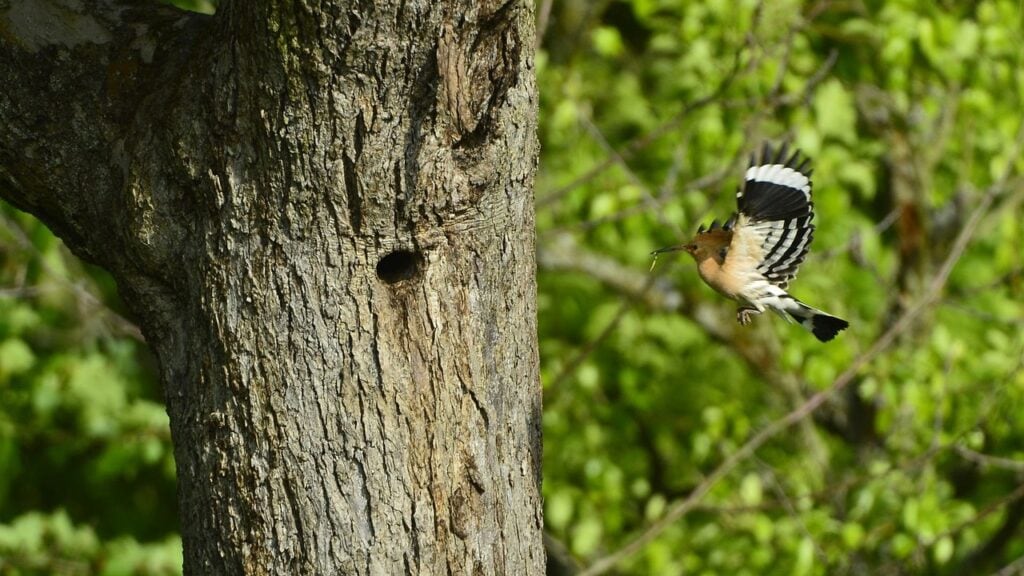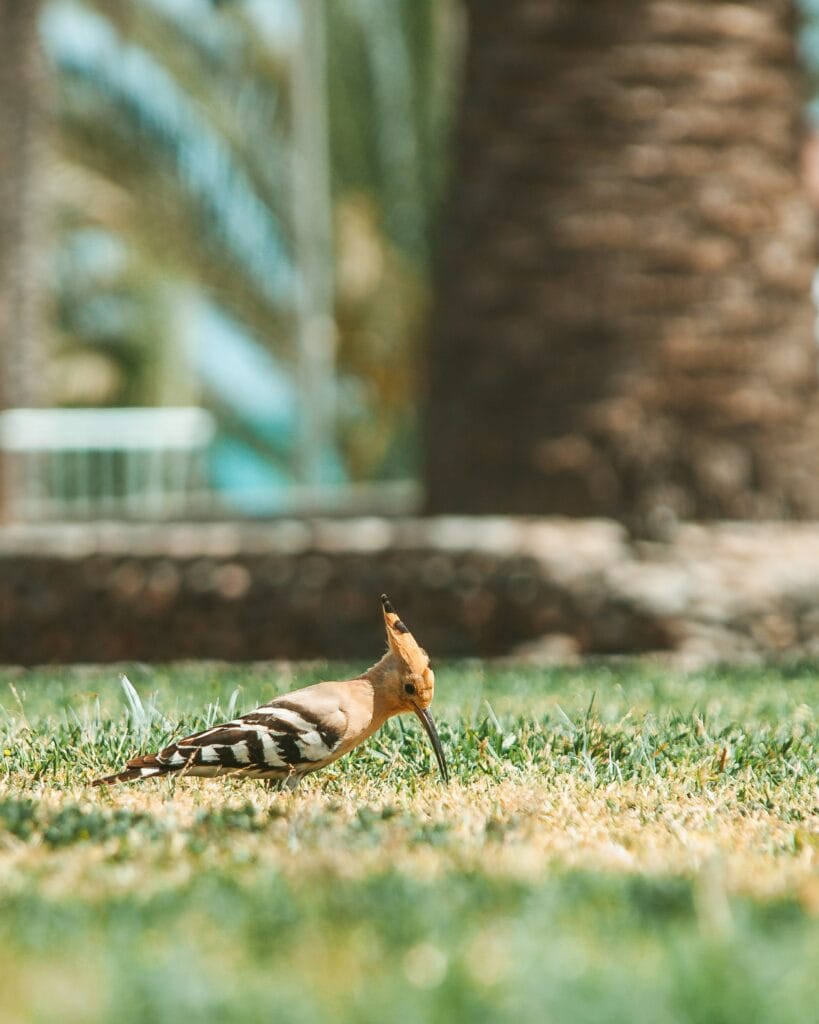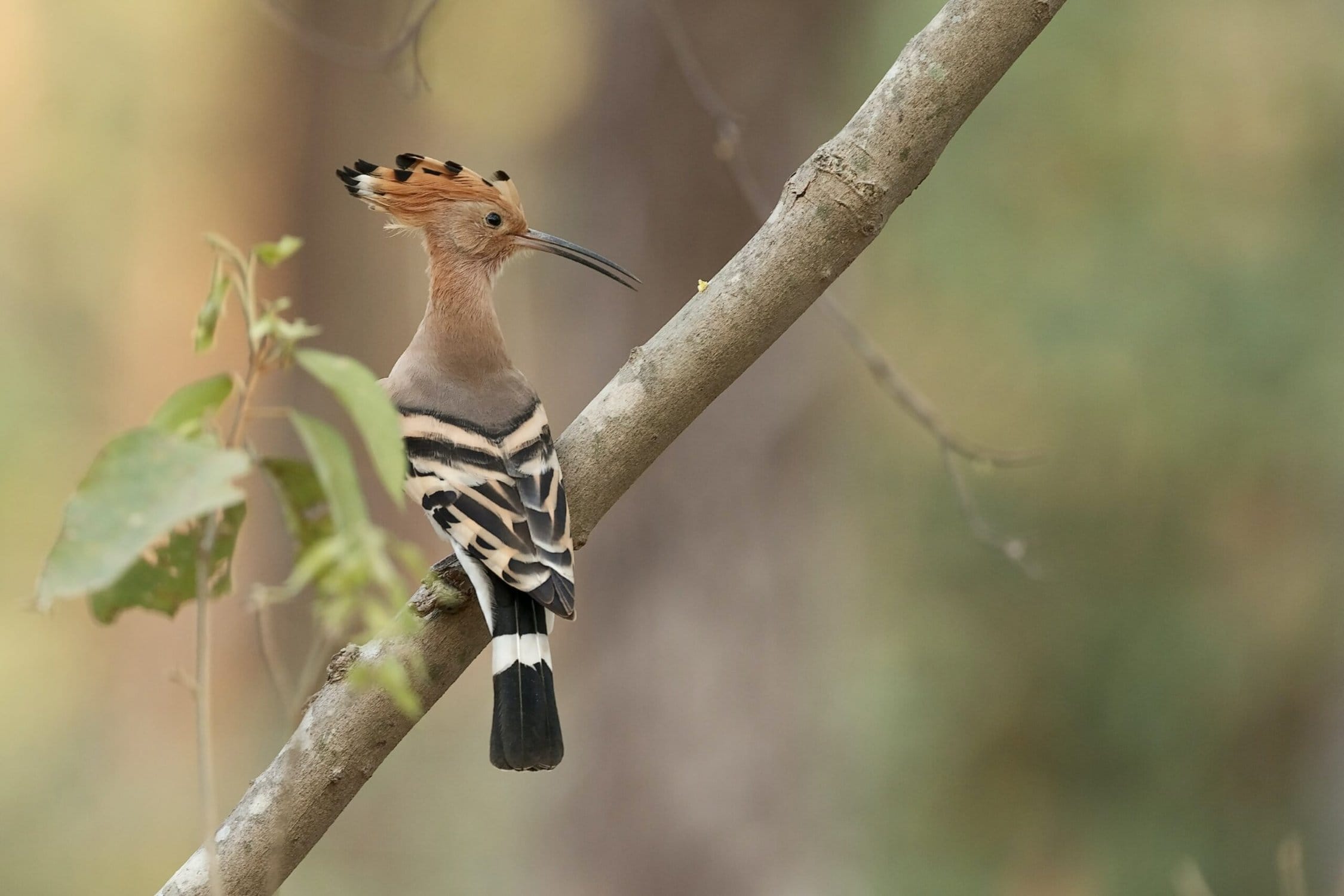The Hoopoe is a striking bird that can be found throughout Africa and Eurasia. Orange in color with black and white stripes, a long lance-like bill, and a flamboyant crest of feathers, the Hoopoe is hard to miss. This bird is associated with a number of myths and religious traditions and is even featured on the coat of arms of several German municipalities.
While the Hoopoe may look like an exotic jungle bird, its presence has been felt throughout human civilizations since ancient times. It is no wonder that this dazzling bird has made such a huge impact. Read on to learn more about the spiritual meaning of the Hoopoe!
Hoopoe Symbolism and Meaning
Hoopoes are known for being fiercely territorial and protective. Hoopoe pairs are monogamous and have developed a number of strategies for defending their nests and their young. Male Hoopoes engage in bloody fights with one another over territory. These brutal confrontations often involve stabbing rivals with their long bills. Because of this, Hoopoes can be associated with violence, war, scrappiness, and defense.
Furthermore, Hoopoe females secrete a foul-smelling liquid from their preening glands. Nesting female Hoopoes spread this liquid, which is reported to smell of rotten meat, all over their feathers and eggs. Serving as a stinky deterrent to predators, this liquid may have another purpose as well.
The secretion is now believed to contain desirable bacteria which prey upon the harmful bacteria found within the birds’ nests and prevent infections. In fact, Hoopoe eggs even have microscopic pits which catch this liquid to ensure that they are thoroughly protected. This adaptation is obviously gross, but it serves a very important purpose. Thus, the Hoopoe can be associated with protection, purification, and natural medicine, along with decay and poor hygiene.

Many cultures uphold the Hoopoe as a sacred or holy bird. The Hoopoe is often connected with wisdom, majesty, kingship, and the divine. Greek mythology associates the Hoopoe with vengeance and brutality.
Hoopoe Native American Symbolism
Hoopoes are not normally found in the Americas. Native American cultures do, however, often see birds in general as messengers that convey the will of the spirits.
Hoopoe Christianity Symbolism
The Hoopoe is listed in the Bible amongst birds that are unclean and not fit to be eaten. In some Abrahamic religious traditions, though, the Hoopoe is more important than this.
The Hoopoe is the national bird of Israel.
In the Quran, the Hoopoe is the messenger of King Solomon:
“And [Solomon] reviewed the birds, and he said, ‘Why do I not see the hoopoe , or is he of those absent? I shall surely punish him severely or slay him, or he must come to me with a clear excuse.’ But [the hoopoe] was not long in coming, and it said, ‘I have found out what you have not apprehended, and I come to you from Sheba with tidings!’”
Hoopoe Celtic Symbolism
In heraldry, the Hoopoe represents inspiration and succession. It is not the most common heraldic symbol, but it is much more widely used than one might expect.
Celtic myths often treat birds as symbols of the Otherworld.
Hoopoe in Dreams
Hoopoe eat insects and are often found foraging on open ground with their long bills. Sunbathing and searching for hidden crickets is a favorite pastime of the Hoopoe. Dreaming of Hoopoes may indicate a need to probe deeper into an issue. Hoopoes find and eat bugs beneath the surface of the ground.
A Hoopoe dream may also signify a message. Hoopoes often appear in myths and cultural traditions as messengers. Dreaming of a Hoopoe might be a reminder to be open-minded and accept the messages that the universe might send to you.
Finally, dreaming of Hoopoes, especially nesting Hoopoes, might refer to protection or prudence. Sometimes the right thing to do smells or looks unsavory, but to protect our happiness and the happiness of our loved ones, we must take the right course of action even if it isn’t the most appealing.

Hoopoe Encounters and Omens
An encounter with a Hoopoe may represent territoriality. Hoopoes are fiercely territorial and are known to battle each other in mid air. These bloody fights can end in fatalities, lost eyes, or serious injuries. A Hoopoe encounter may mean that you feel insecure in your territory or that an intruder has entered your space. The Hoopoe reminds us to do what we must to protect our homes, but to remember that the cost of violence is often very steep.
Encountering a Hoopoe nest can signal that things in your life are not as bad as they appear to be. A Hoopoe nest likely smells like a rancid unclean place, but this is actually due to the protections that the mother Hoopoe has put in place for her young. Consider whether your circumstances are as rotten as they seem and search for things to focus on that fill you with gratitude.
Hoopoe in Mythology & Folklore
Hoopoe mythology is widespread and ancient. This magnificent bird is a frequent muse which has inspired artists and story-tellers across the globe.
Persian Mythology:
The Conference of Birds is a beloved and significant piece of Persian literature. The poem, which explores themes of folly, longing, stagnation, and enlightenment, sees the birds of the world attempt to name a king. The birds decide to seek out a legendary beast to serve as their king, under the suggestion of the Hoopoe who is the most wise of the birds. The Hoopoe must then convince the birds to journey and find this legendary king, despite each bird’s unique excuse for why they cannot do it. In The Conference of Birds, the Hoopoe is the voice of reason who delivers the wisdom and morals at the heart of the poem’s narrative.
Christian/Jewish Mythology:
As mentioned above, the Quran names the Hoopoe as the messenger of King Solomon. As a result, there are a number of folk tales, not found in the Quran itself, which feature King Solomon and the Hoopoe together. According to one such legend, King Solomon is responsible for the crest atop the heads of Hoopoes. In this story, King Solomon was flying on the back of a great eagle when the hot sun began to blind and frustrate him. Noticing his distress, a flock of Hoopoes flew above his head and joined their wings together to form a giant shade.
Thankful to be shielded from the sun’s rays, Solomon offered the Hoopoes whatever their hearts desired. The Hoopoes asked for a golden crown. So, Solomon crowned the Hoopoes in gold, though he warned them that a gold crown would be cumbersome. Eventually, hunters began hunting the Hoopoes for their golden crowns, so they begged Solomon to take back their wish. Solomon, pitying the birds, granted their wish and replaced their golden crowns with feathered crests. Hoopoes proudly wear that feathered crest to this day.

Egyptian Mythology:
The Hoopoe is present in ancient Egyptian art where it is depicted as a protector of tombs and a symbol of royalty. The Hoopoe is often combined with solar motifs and is associated with kingship and fatherhood. In tombs, the Hoopoe is considered a guardian which protects the spirit on its journey to the realm of the dead. When a Hoopoe is depicted in the hands of a child in Egyptian art, this signifies that the child is his father’s rightful successor and heir.
Greek Mythology:
The extremely brutal Greek myth of King Tereus features the Hoopoe. According to legend, Tereus was the son of Ares and the king of Thrace. Tereus was married to a young woman named Procne with whom he had a son. One day, Procne came to Tereus and begged him to allow her beloved sister, Philomela, to come to Thrace and visit them. Tereus agreed and Philomela came to stay with them. Tereus began to lust after Philomela and lured her into the woods in order to rape her.
After assaulting Philomela, Tereus cut out her tongue so that she could tell no one what had happened to her. Philomela was clever, though, and she wove the events into a tapestry which she brought to Procne. Procne was enraged and the sisters swore to get their revenge. They slew Procne and Tereus’s son and fed him to his father. When Tereus learned of their cruel vengeance, he chased the sisters down and tried to kill them both. In their panic, Procne and Philomela begged for assistance from the gods. Seeing the violence that had occurred, the gods turned each of the three into birds. Philomela became a nightingale, Procne became a swallow, and Tereus became a Hoopoe.
Hoopoe Spirit Animal
If the Hoopoe is your spirit animal then you are crafty, resourceful, brave, and scrappy. People with the Hoopoe spirit animal will do anything to protect what matters to them. The Hoopoe spirit animal tends to be family-oriented and is often found in protective parents.
People with the Hoopoe spirit animal are not afraid to get their hands dirty when it comes to defending what is right. The Hoopoe spirit animal holds grudges and will seek revenge when it feels wronged. If your spirit animal is the Hoopoe then you may have a bit of a temper, but you are likely very gentle and tender with the people who matter most to you.
People who have the Hoopoe as their totem animal tend to enjoy peace and quiet and are very comfortable spending time by themselves. They may butt heads with louder or more extroverted personalities.
Hoopoe Totem Animal
The Hoopoe totem animal is associated with healing and purification. Medicine is not always pleasant, but much like the Hoopoe’s smelly secretions, people with the Hoopoe totem animal know that healing and protection is worth the cost.
People with the Hoopoe totem animal may feel drawn towards healing or nurturing roles. Although they do have tempers, Hoopoe totems treasure innocence and are patient with children especially.
The Hoopoe totem animal may express love and affection through food. People with this totem animal love to cook and are exactly the type to bring a hot bowl of chicken soup to a sick friend.
Hoopoe Power Animal
The power of the Hoopoe lies in messages. The Hoopoe appears in many stories and traditions as a divine messenger. People who have the Hoopoe as their power animal may find themselves to be the frequent recipients of messages from the universe.

The Hoopoe power animal tends to be found in people who are open-minded and comfortable with accepting things beyond the scope of their knowledge. Being comfortable with the unknown and open to learning new things is an essential trait of the Hoopoe power animal.
Hoopoe Tattoo Meaning
A Hoopoe tattoo may represent protection, defense, family, or guardianship. One might choose a Hoopoe tattoo to represent the ideal of protecting one’s home against negative energies or influences.
A Hoopoe tattoo may also represent messages. Someone with a Hoopoe tattoo may choose this tattoo to represent an open-minded philosophy guided by the wisdom of the universe.
A Hoopoe tattoo may be religious in nature and may refer to King Solomon’s messenger.
Finally, a tattoo featuring the Hoopoe might refer to violence or confrontation. Hoopoes are unafraid to utilize violence when their cause is important enough. Such a tattoo might be chosen to represent self-defense.
Conclusion
The Hoopoe is a mesmerizingly pretty animal whose ornate feathers only scratch the surface of this bird’s fascinating traits. From Greek mythology to Egyptian hieroglyphs, to Persian poetry, to the Quran, the Hoopoe has inspired humanity since ancient times and continues to do so with its spunky personality and breath-taking looks. When it comes to meaningful birds, the Hoopoe is the total package!

